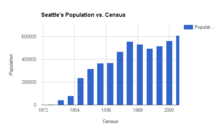Demographics of Seattle
Only about a fifth of the households include minor children, and more people live alone here than any other U.S. city besides San Francisco.
There were 270,524 housing units at an average density of 1,245.4 units/km2 (3,226 units/sq mi).During the day, incoming commuters increase Seattle's population by about 30%.
Seattle has the largest African American population of any city in the Pacific Northwest, it is largely concentrated in the Central District, High Point and Rainier Beach neighborhoods, which are at least 15% Black.
While Seattle's Hispanic population is only 6.6%, it is largely concentrated on the city's South Park neighborhood.
[13] Although the 2000 census shows only 5.28% of the population as Hispanic or Latino of any race, Hispanics are believed to be the most rapidly growing population group in Washington State, with an estimated increase of 10% just in the years 2000–2002.
According to the 2010 United States Census, Seattle had a population of 608,660 with a racial and ethnic composition as follows:[15] The racial composition of the city in 2016 was 65.7% White, 14.1% Asian, 7.0% Black, 0.4% Native American, 0.9% Pacific Islander, 2.3% from other races, and 5.6% from two or more races.
[16] Amongst the city's European origin population, 11.3% were of German, 9.1% Irish, 8.1% English and 5.0% Norwegian ancestry according to Census 2000.
As of January 27, 2017, according to the Point-In-Time Count in Seattle/King County, an annual count of individuals, youth, and families experiencing homelessness in Seattle and King County, there were a total of 11,643 individuals experiencing homelessness, of which 47% were unsheltered, which included 13% on the street, 20% in vans or RVs, 13% in tents and 1% in abandoned buildings.
